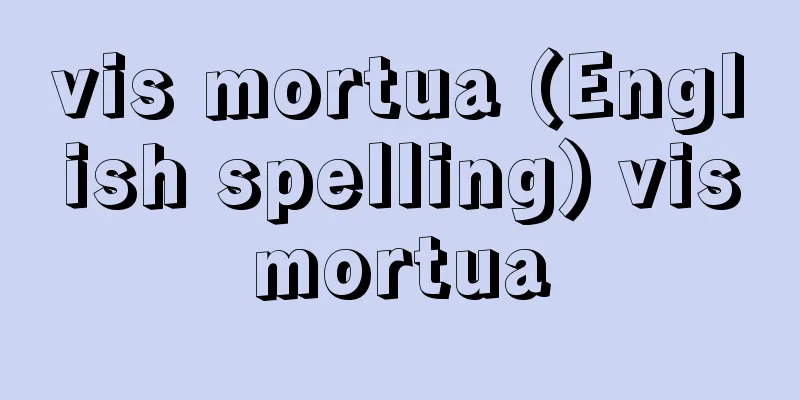Kamo Shrine

|
This refers to Kamo Wakeikazuchi Shrine (Kamigamo Shrine) and Kamo Mioya Shrine (Shimogamo Shrine) in Kyoto City, as well as shrines whose deities have been enshrined in various regions. Kamigamo Shrine and Shimogamo Shrine have been revered by the Imperial Court since ancient times, and especially after Emperor Kanmu moved the capital to Heian, they were treated second only to the Grand Shrine of Ise, so the reverence for the shrines spread widely among the common people and they were enshrined throughout the country. Kamigamo Shrine is located in Kamigamo Motoyama, Kita Ward, Kyoto City, and enshrines Kamo Wakeikazuchi no Kami, while Shimogamo Shrine is located in Shimogamo Izumigawa-cho, Sakyo Ward, Kyoto City, and enshrines Kamo Okami, Tamayorihime no Mikoto, and Kamo Taketsunomi no Mikoto. Tamayorihime was the daughter of Kamo Taketsunumi and the mother of Kamo Wakeikazuchi. [Junichi Kamata] HistoryThe founding dates of both shrines are unknown. According to the shrine legend, Kamigamo Shrine descended to its current location at Kōyama, north-northwest of the current location, during the reign of Emperor Jinmu, while Shimogamo Shrine descended to Mikageyama, on the western foot of Mount Hiei, during the reign of Emperor Jinmu, and both shrines were enshrined at their current locations in the 6th year of the reign of Emperor Tenmu (677). The two shrines have been collectively called Kamo Shrine since long ago, before the Nara period, and when they were referred to individually, they were called Kamigamo Shrine (Kamisha, Kamokamisha) and Shimogamo Shrine (Shimosha, Kamoshitasha) due to their relative locations. It is known from the Shoku Nihongi that the Kamo Festival was already being held on a grand scale in 702 (Taihō 2). In 726 (Jinki 3), the Imperial Court offered offerings to the shrine for the first time, and in 745 (Tenpyo 17), Emperor Shomu offered offerings and prayers to the shrine for the untimely death of his father. When the capital was moved to Nagaoka-kyo in 784 (Enryaku 3), an envoy was sent to report the move, offerings were made, the shrine was promoted to Junior Second Rank, and a shrine building was constructed. The following year, ten households were donated to both the upper and lower shrines. In 794 (Enryaku 13), Emperor Kanmu made an imperial visit to the main shrine after the capital was moved to Heian, and the shrine was highly revered as a deity protecting the imperial palace, and in 807 (Daido 2), the shrine was promoted to Senior First Rank. In 810 (Kōnin 1), Emperor Saga established the system of Kamo Saiin, modeled after the Saigū system of Ise Jingū, and appointed his daughter, Princess Uchishi, as Saiō, a system that continued until the reign of Emperor Gotoba. Under the Engi system, it was ranked as a Myojin Taisha (famous shrine), and received offerings for Tsukinami, Ainame, Niiname, and other occasions, as well as offerings for rain and rain cessation. Around this time, the system of Shikinen Sengu (a periodic rebuilding of the shrine) held once every 21 years was established, and in 1090 (Kanji 4), Emperor Horikawa donated over 600 cho of non-exportable land to both the Upper and Lower Shrines. As the system of 22 shrines was established, the Upper and Lower Shrines were treated as one shrine, and were also designated as the Ichinomiya (first shrine) of Yamashiro Province. In the Middle Ages, Minamoto no Yoritomo granted the shrine's land titles to the Emperor Go-Toba and the Retired Emperor Go-Toba often offered prayers there. During the Jōkyū Incident (1221), the shrine's family even sided with the emperor, but the reverence for the shrine by both the court and common people remained unchanged, and its worship by the common people in particular spread throughout the country. Toyotomi Hideyoshi, after unifying the country, confiscated the shrine lands and instead bestowed red seal territories of 2,572 koku for the Kamisha and over 540 koku for the Shimosha, which were largely inherited by the Edo Shogunate. Under the Meiji system, they were designated as Kanpei Taisha and placed at the top of all national Kanpeisha because they had been treated with the utmost care by the Imperial Family, second only to the Grand Shrine of Ise, and had been visited by Imperial family members, regents made pilgrimages to the Kamo Shrine, samurai families visited the shrines, and common people had faith in them, and these have remained unchanged throughout history. [Junichi Kamata] Festivals and shrinesThe annual festival (May 15th) is said to have originated from a passage in the Kamo Engi, which tells of an unfavorable weather during the reign of Emperor Kinmei, when the people prayed and the land was made Toyohira. Since the early Heian period, it has been an imperial festival and was called the Kamo Festival, but it is also called the Aoi Festival because in the past, imperial envoys and other participants in the ritual would hang vines of Aoi kadzu wigs. This Aoi Festival was held from 1467 (Onin 1) to 1693 (Genroku 6), and was temporarily abolished at the start of the Meiji period, but the old ritual is still well known today. The festival begins with the Miare ritual at the Kamisha Shrine on May 12th and the Mikage Festival at the Shimosha Shrine, and on the 15th, an imperial envoy departs from the Kyoto Imperial Palace to visit Shimogamo Shrine, and after the rituals, visits Kamigamo Shrine, where a ritual is performed. It is one of the three imperial festivals. The horse racing ritual at Kamigamo Shrine on May 5th is a ritual that dates back to the "Kurabeuma" ritual in 1093 (Kanji 7), and many of the special rituals at this shrine retain the roots of Shinto rituals. The main hall and the gonden (second hall) of Kamigamo Shrine were built in 1863 (Bunkyu 3) and are designated as national treasures, preserving their ancient style. The east and west halls of Shimogamo Shrine were also rebuilt in the same year and are designated as national treasures as representative examples of Nagare-zukuri architecture. The grounds of both shrines are designated as historic sites. Kamigamo Shrine is home to the Mite Bunko Library, which contains votive documents by the Japanese scholar Imai Jikan. [Junichi Kamata] Kamo Shrine territoryThe land of both Kamigamo and Shimogamo shrines. The donation of fiefs is thought to date back to the reign of Emperor Kōtoku, but the earliest known donation from historical sources is in 785 (Enryaku 4), when 10 households were donated to the upper and lower shrines, and according to documents from 806 (Daido 1), there were 24 households at the upper shrine and 20 at the lower shrine at that time. In 942 (Tenkei 5), offerings were made in gratitude for the suppression of the East-West Rebellion (the rebellion of Taira Masakado and Fujiwara Sumitomo), and Emperor Suzaku made his first visit to Kamo Shrine, donating 10 households to the upper and lower shrines. There were also some donations of fiefs after this. In addition, by the end of the Heian period, a kanbe of over 70 households at the upper shrine and over 20 at the lower shrine had been formed. As for Kanda, one cho each was donated to the Upper and Lower Shrines in 750 (Tenpyo Shoho 2), and by 848 (Jowa 15), another one cho each was donated, with smaller donations made thereafter. Around the time of Emperor Goichijo's visit in 1017 (Kannin 1), the Atago district was donated as a sacred district (the four districts of Kamo, Nishigori, Ono, and Ono were the Kamisha territory, and the four districts of Tadekura, Kurino, Kamiawata, and Izumo were the Shimosha territory). However, as other territories were mixed within the district, there were constant disputes, especially with Enryakuji Temple. In 1090 (Kanji 4), during the Shirakawa Insei period, more than 600 cho of non-exchangeable land and a kitchen were donated to the Upper and Lower Shrines at the request of Muso. Some of these include Mitsusho in Awa Province, Miyakawasho in Wakasa Province, Kanazusho in Kaga Province, Kawachisho in Mimasaka Province, Namahosho in Awaji Province, Takeharasho in Aki Province, and Tsunosho in Tosa Province. However, including Mikuriya and non-rented land, they are found mostly along the Seto Inland Sea coast, along the Hokuriku and San'in roads, around Lake Biwa, and in the basins of major rivers in Owari and Mino. This shows that there was a close relationship between the organization of the Shinto priests who engaged in maritime traffic, shipping, and fishing, and the formation of the Kamo Shrine territory. In the Kamakura period, protection was added due to the donation of land by Minamoto no Yoritomo. In the Edo period, the Upper Shrine was granted 2,752 koku and the Lower Shrine 540 koku. [Mitsuo Tanahashi] Source: Shogakukan Encyclopedia Nipponica About Encyclopedia Nipponica Information | Legend |
|
京都市の賀茂別雷(わけいかずち)神社(上賀茂神社)、賀茂御祖(みおや)神社(下鴨(しもがも)神社)、またその祭神を各地に勧請(かんじょう)した神社のこと。上賀茂社・下鴨社は古くより朝廷の崇敬を受け、ことに桓武(かんむ)天皇の平安遷都後、伊勢(いせ)の神宮に次ぐ所遇を受けたため、その社に対する崇敬は広く庶民に及び、全国に勧請された。上賀茂社は京都市北区上賀茂本山(もとやま)に鎮座し、賀茂別雷神を祀(まつ)り、下鴨社は京都市左京区下鴨泉川町に鎮座し、賀茂皇大神(すめおおかみ)、玉依媛命(たまよりひめのみこと)、賀茂建角身命(たけつのみのみこと)を祀る。玉依媛命は賀茂建角身命の娘で、賀茂別雷神の母にあたる。 [鎌田純一] 沿革両社の創建年代は不詳。社伝によれば、上賀茂社は神武(じんむ)天皇の代、現在地の北北西神山(こうやま)に降臨、下鴨社は同じく神武天皇の代、比叡山(ひえいざん)の西麓(せいろく)御蔭(みかげ)山に降臨、それぞれ奉斎されていたが、ともに天武(てんむ)天皇6年(677)に現在地に社殿を造営されたという。古く奈良以前より両社をあわせて賀茂社といい、一社ごとのときは、鎮座地の関係で、上賀茂社(上社、賀茂上社)、下鴨社(下社、賀茂下社)と呼称した。702年(大宝2)賀茂祭がすでに盛大になされていたことが『続日本紀(しょくにほんぎ)』により知られる。726年(神亀3)朝廷より初めて奉幣、745年(天平17)聖武(しょうむ)天皇の不予に奉幣祈祷(きとう)され、784年(延暦3)長岡京への遷都にあたって、使者を派遣し奉告、奉幣、従(じゅ)二位に叙し、社殿を造営、翌年上下両社へ神封各10戸を寄せている。794年(延暦13)桓武天皇は平安遷都ののち、本社へ行幸、以後、皇城鎮護の神として厚く崇敬され、807年(大同2)正一位となる。嵯峨(さが)天皇は810年(弘仁1)伊勢神宮の斎宮(さいくう)の制に倣って賀茂斎院の制を始め、皇女有智子(うちし)内親王を斎王とし、以後後鳥羽(ごとば)天皇の代まで続けられた。延喜(えんぎ)の制で名神(みょうじん)大社に列し、月次(つきなみ)・相嘗(あいなめ)・新嘗(にいなめ)などの奉幣にあずかり、ほか祈雨(きう)・止雨(しう)などの奉幣も受けた。このころ、21年に一度の式年遷宮の制も定められ、1090年(寛治4)堀河(ほりかわ)天皇は上下両社に不輸租田各600余町を奉献された。また二十二社の制が整うとともに、上下社一体としてその一社とされ、山城(やましろ)国一宮(いちのみや)ともされた。中世に至り源頼朝(よりとも)はその社領を安堵(あんど)、後鳥羽上皇はしばしば祈願して、承久(じょうきゅう)の変(1221)にはその社家は院側につくようなこともあったが、朝野の崇敬は変わらず、ことに庶民崇敬が全国に広がった。 豊臣(とよとみ)秀吉は全国統一ののち、社領を没収、かわりに上社に2572石、下社に540石余の朱印領を寄せ、江戸幕府もおよそこれを継承した。明治の制で、それぞれ官幣大社とされ、全国官国幣社の首位に置かれたのは、古来伊勢の神宮に次いで皇室の厚い所遇を受け、皇族の参詣(さんけい)、摂関の賀茂詣(もう)で、武家の社参、また庶民の信仰、歴史を通じ変わらぬところのあったためである。 [鎌田純一] 祭礼・社殿例祭(5月15日)は、『賀茂縁起』に欽明(きんめい)天皇の代、風雨順ならず、よって祈願し天下豊平となったことに発するともいわれる。平安初期以来、勅祭とされ、賀茂祭(まつり)と称したが、一名を葵祭(あおいまつり)といわれるのは、古く勅使以下祭儀に加わる者が葵鬘(あおいかずら)の蔓(つる)をかけたことによる。この葵祭は1467年(応仁1)より1693年(元禄6)までとだえ、明治初年にも一時廃止されたが、現在によくその旧儀を伝えている。祭りの次第は、5月12日の上社の御阿礼(みあれ)神事、下社の御蔭(みかげ)祭に始まり、15日に京都御所より勅使が出発、下鴨社に参向、祭儀ののち上賀茂社に参向し、祭儀が厳修される。三勅祭の一つ。また上賀茂社の5月5日の競馬会(けいばえ)神事は1093年(寛治7)の「くらべうま」以来の神事であり、当社の特殊神事には神道祭祀(さいし)の根源を残したものが多い。 上賀茂社の本殿、権殿(ごんでん)は1863年(文久3)の建造であるが古式を残して国宝に、下鴨社の東本殿、西本殿も同年の再建で、流造(ながれづくり)の代表建築で国宝に指定されている。両社境内とも史跡指定。上賀茂社には国学者今井似閑(じかん)の奉納書を中心とする三手(みて)文庫がある。 [鎌田純一] 賀茂神社領上賀茂・下鴨両社の社領。封戸(ふこ)の寄進は孝徳(こうとく)朝にさかのぼると思われるが、史料的に明らかなものとしては、785年(延暦4)上下社に各10戸を寄進したとするのが早く、806年(大同1)の文書によれば当時上社24戸、下社20戸が存在していた。942年(天慶5)には、東西反乱(平将門(まさかど)・藤原純友(すみとも)の乱)平定を謝して奉幣があり、また朱雀(すざく)天皇が初めて賀茂社に行幸することがあって、上下社に各10戸が寄進された。この後も封戸(ふこ)若干の寄進があった。このほか平安末期までには、上社70余戸、下社20余戸の神戸(かんべ)が形成されていた。神田については、750年(天平勝宝2)上下社に各1町、848年(承和15)までにはさらに各1町が寄進され、この後も小規模な寄進があった。1017年(寛仁1)の後一条天皇の行幸にかけて、愛宕(おたぎ)一郡を神郡として寄進した(賀茂・錦部(にしごり)・小野・大野4郷が上社領、蓼倉(たでくら)・栗野(くるすの)・上粟田(かみあわた)・出雲(いずも)4郷が下社領)。ただし、郡内には他の所領が入り交じっていたため、とくに延暦寺(えんりゃくじ)などとの間で紛争が絶えなかった。1090年(寛治4)、白河院政期、夢想の告によって上下社に不輸租田各600余町と御厨が寄進された。後の阿波(あわ)国三津荘(しょう)、若狭(わかさ)国宮河(みやかわ)荘、加賀国金津(かなつ)荘、美作(みまさか)国河内(こうち)荘、淡路国生穂(なまいほ)荘、安芸国竹原荘、土佐国津野荘などがその一部であるが、御厨、不輸租田を含め、瀬戸内海沿岸、北陸道、山陰道の沿岸、琵琶(びわ)湖周辺、尾張(おわり)・美濃(みの)の大河川流域などに多いことが明らかで、海上交通、舟運、漁労に従事した神人(じにん)の組織化と賀茂社領の形成に密接な関係があったことを物語っている。鎌倉期に入って、源頼朝(よりとも)の所領寄進などもあり、保護が加えられた。江戸時代には、上社2752石、下社540石が認められた。 [棚橋光男] 出典 小学館 日本大百科全書(ニッポニカ)日本大百科全書(ニッポニカ)について 情報 | 凡例 |
<<: Kamo Taketsunomi no Mikoto - Kamo Taketsunomi no Mikoto
>>: Record of the relocation of the Kamo Shrine
Recommend
Salt - Shio
〘noun〙① A substance with a salty taste. Made from ...
Hobson, John Atkinson
Born: July 6, 1858, Derby, Derbyshire [Died] April...
The Great Society
...So in 1964, a large tax cut was implemented th...
Stradivari - Antonio Stradivari
Italian string instrument maker. He is considered...
The Condition of the Working Class in England
…From this starting point, he attempted a critica...
Gilbert-Maxam law
…Deoxyribonucleic acid is an abbreviation for deo...
Asukabehime - Asukabehime
…She became the wife of Prince Yasuyuku when Prin...
Arcueil School - Arcueil School
... Satie was almost the same age as Debussy, but...
chute
…These remains give a real sense of the fact that...
Oshima clan
…The various Ama clans, led by their chiefs (Ama ...
Hornbeam maple (English spelling)
...Also, A. nipponicum Hara (distributed in Honsh...
Quercus sessilifolia (English spelling) Quercussessilifolia
…[Motoji Okamoto] [Aya Nitta]. … *Some of the ter...
Base of leg gland -
…The antennal gland consists of a coelomic pouch,...
cush-cush yam (English spelling) cushcushyam
…It is widely distributed in the wild in the trop...
Political system
A theoretical model that treats political phenomen...









